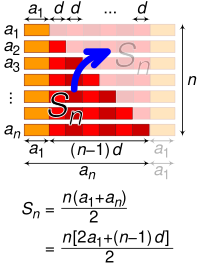Arithmetic sequence

An arithmetic sequence is a group of numbers that follow a certain pattern. Imagine you have a friend who loves to count, and his favorite number is 3. He starts counting by 3s, and he says, "3, 6, 9, 12, 15..." That's an arithmetic sequence! Each number is 3 more than the one before it. Another example is the sequence "2, 4, 6, 8, 10, 12..." where each number is 2 more than the one before it.
Let's break that down a little more:
- A sequence is just a group of numbers, like in our examples above.
- "Arithmetic" means that there is a certain amount that gets added (or subtracted) each time to get to the next number in the sequence. In our first example, that amount was 3. In the second, it was 2.
- So in an arithmetic sequence, each number is the same amount more (or less) than the one before it. That amount is called the "common difference."
Arithmetic sequences can be really helpful in a lot of math problems. They're also kind of like a puzzle that you can solve by figuring out the common difference and using it to find missing numbers in the sequence. Plus, it's always fun to count with your friends!
Let's break that down a little more:
- A sequence is just a group of numbers, like in our examples above.
- "Arithmetic" means that there is a certain amount that gets added (or subtracted) each time to get to the next number in the sequence. In our first example, that amount was 3. In the second, it was 2.
- So in an arithmetic sequence, each number is the same amount more (or less) than the one before it. That amount is called the "common difference."
Arithmetic sequences can be really helpful in a lot of math problems. They're also kind of like a puzzle that you can solve by figuring out the common difference and using it to find missing numbers in the sequence. Plus, it's always fun to count with your friends!
Related topics others have asked about:
Arithmetico-geometric sequence,
Generalized arithmetic progression,
Geometric progression,
Harmonic progression (mathematics),
Inequality of arithmetic and geometric means,
Integer triangle,
Linear difference equation,
Polynomials calculating sums of powers of arithmetic progressions,
Primes in arithmetic progression,
Problems involving arithmetic progressions,
Triangular number,
Utonality
